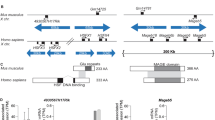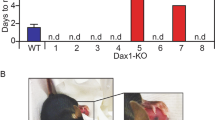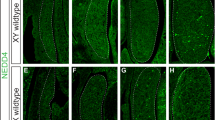Abstract
An approach designed to map and generate mutations in the region of the short arm of the mouse Y chromosome, known to be involved in sex determination and spermatogenesis, is described. This relies on homologous Yp–Sxra pairing and asymmetrical exchange which can occur at meiosis in XY males carrying Sxra on their X chromosome. Such exchange potentially generates deficiencies and duplications of Yp or Sxra. Three fertile XY females were found out of about 450 XY offspring from XSxra/Y x XX crosses. In all three, despite evidence for deletion of Y chromosomal material, the Sry locus was intact. Each deletion involved a repeat sequence, Sx1, located at a distance from Sry. Since expression of Sry was affected these results suggest that long range position effects have disrupted Sry action.
This is a preview of subscription content, access via your institution
Access options
Subscribe to this journal
Receive 12 print issues and online access
$209.00 per year
only $17.42 per issue
Buy this article
- Purchase on Springer Link
- Instant access to full article PDF
Prices may be subject to local taxes which are calculated during checkout
Similar content being viewed by others
References
Cattanach, B.M., Pollard, C.E. & Hawkes, S.G. Sex reversed mice: XX and XO males. Cytogenetics 10, 318–337 (1971).
McLaren, A. et al. Location of the genes controlling H-Y antigen expression and testis determination on the mouse Y chromosome. Proc. natn. Acad. Sci. U.S.A. 85, 6442–6445 (1988).
Roberts, C. et al. Molecular and cytogenetic evidence for the location of Tdy and Hya on the mouse Y chromosome short arm. Proc. natn. Acad. Sci. U.S.A. 85, 6446–6449 (1988).
Evans, E.P., Burtenshaw, M.D. & Cattanach, B.M. Meiotic crossing over between the X and Y chromosomes of male mice carrying the sex-reversing (Sxr) factor. Nature 300, 443–445 (1982).
McLaren, A. & Monk, M. Fertile females produced by inactivation from X chromosome of ‘sex-reversed1’mice. Nature 300, 443–448 (1982).
Cattanach, B.M., Rasberry, C., Burtenshaw, M. & Evans, E.P. Illegitimate pairing of the X and Y chromosomes in Sxr mice. Genet. Res. 56, 121–128 (1990).
McLaren, A., Simpson, E., Tomonari, K., Chandler, P. & Hogg, H. Male sexual differentiation in mice lacking H-Y antigen. Nature 312, 552–555 (1984).
Simpson, E.M. & Page, D.C. An interstitial deletion in mouse Y chromosomal DNA created a transcribed Zfy fusion gene. Genomics 11, 609–620 (1991).
Gubbay, J. et al. A gene mapping to the sex-determining region of the mouse Y chromosome is a member of a novel family of embryonically expressed genes. Nature 346, 245–250 (1990).
Koopman, P., Münsterberg, A., Capel, B., Vivian, N. & Lovell-Badge, R. Expression of a candidate sex-determining gene during mouse testis differentiation. Nature 348, 450–452 (1990).
Koopman, P., Gubbay, J., Vivian, N., Goodfellow, P. & Lovell-Badge, R. Male development of chromosomally female mice transgenic for Sry. Nature 351, 117–121 (1991).
Berta, P. et al. Genetic evidence equating SRY and the male sex determining gene. Nature 348, 248–250 (1990).
Harley, V.R. et al. DNA binding activity of recombinant SRY from normal males and XY females. Science 255, 453–456 (1992).
Palmer, S.J. & Burgoyne, P.S. The Mus musculus domesticus Tdy allele acts later than the Mus musculus musculus Tdy allele: A basis for XY sex reversal in C57BI/6-Ypos mice. Development 113, 709–714 (1991).
Bishop, C.E. & Mitchell, M.J. The molecular biology of the mouse Y chromosome. Semin. Dev. Biol. 2, 241–249 (1991).
Gubbay, J. et al. Inverted repeat structure of the Sry locus in mice. Proc. natn. Acad. Sci. U.S.A. 89, 7953–7957 (1992).
Whitten, W.K., Carter, S.C. & Beamer, W.G. Sex reversing non-disjunction of the Y chromosome produces exceptionally low sex ratio (% males) and hermaphrodites in the progeny of male BALB/cBm mice: the roles of the maternal genotype and the Y chromosome. Reprod. Fertil. Dev. 3, 255–265 (1991).
Lovell-Badge, R.H. & Robertson, E. XY female mice resulting from a heritable mutation in the murine primary testis determining gene, Tdy. Development 109, 635–646 (1990).
Mahadevaiah, S.K., Lovell-Badge, R. & Burgoyne, P.S. Tdy-negative XY, XXY and XYY female mice breeding data and synaptonemal complex analysis. J. reprod. Fertil. 97, 151–160 (1992).
Hunt, P.A. Survival of XO mouse fetuses: effect of parental origin of the X chromosome or uterine environment?. Development 111, 1137–1141 (1991).
McLaren, A., Simpsom, E., Bishop, C.E., Mitchell, M. & Darling, S. Recombination between the X and Y chromosomes and the Sxr region of the mouse. Genet. res. Camb. 60, 175–184 (1992).
Mitchell, M.J. & Bishop, C.E. A structural analysis of the Sxr region of the mouse Y chromosome. Genomics 12, 26–34 (1992).
Bishop, C.E., Weith, A., Mattei, M.G. & Roberts, C. Molecular aspects of sex determination in mice: an alternative model for the origin of the Sxr region in sex determination in mouse and man (eds Maclaren, A. & Ferguson-Smith, M.A.) 119–124 (Royal Society, London, 1988).
Bishop, C.E., Boursot, P., Baron, B., Bonhomme, F. & Hatat, D. Most classical Mus musculus domesticus laboratory mouse strains carry a Mus musculus musculus Y chromosome. Nature 315, 70–72 (1985).
Eicher, E.M. & Washburn, L.L. Genetic control of primary sex determination in mice. Ann. Rev. Genet. 20, 327–360 (1986).
Cattanach, B.M., Rasberry, C. & Beechey, C.V. Sex reversal and retardation of embryonic development. Mouse News Letter 82, 94 (1988).
Burgoyne, P.S. & Palmer, S.J. The genetics of XY sex reversal in the mouse and other animals. Semin. dev. Biol. 2, 277–284 (1991).
Cattanach, B.M. Sex-reversed mice and sex determination. Ann. N.Y. Acad. Sci. 513, 27–29 (1987).
Palmer, M.S. et al. Genetic evidence that ZFY is not the testis-determining factor. Nature 342, 937–939 (1989).
McElreavey, K. et al. XY sex reversal associated with a deletion 5′to the SRY “HMG box” in the testis-determining region. Proc. natn. Acad. Sci. U.S.A. 89, 11016–11020 (1992).
Russell, L.B. Numerical sex chromosome anomalies in mammals: their spontaneous occurrence and use in mutagenesis studies in Chemical mutagens. Principles and methods for their detection, vol. 4, (ed A. Hollaender) 55–91 (Plenum Press, London, 1976).
Author information
Authors and Affiliations
Rights and permissions
About this article
Cite this article
Capel, B., Rasberry, C., Dyson, J. et al. Deletion of Y chromosome sequences located outside the testis determining region can cause XY female sex reversal. Nat Genet 5, 301–307 (1993). https://doi.org/10.1038/ng1193-301
Received:
Accepted:
Issue Date:
DOI: https://doi.org/10.1038/ng1193-301
This article is cited by
-
A lack of coordination between sister-chromatids segregation and cytokinesis in the oocytes of B6.YTIR (XY) sex-reversed female mice
Scientific Reports (2017)
-
A primer on the use of mouse models for identifying direct sex chromosome effects that cause sex differences in non-gonadal tissues
Biology of Sex Differences (2016)
-
An autosomal locus controls sex reversal in interspecific XY hybrids of the medaka fishes
Heredity (2011)
-
A sex-determining region on the Y chromosome controls the sex-reversal ratio in interspecific hybrids between Oryzias curvinotus females and Oryzias latipes males
Heredity (2010)
-
The mouse A/HeJ Y chromosome: Another good Y gone bad
Chromosome Research (2008)



